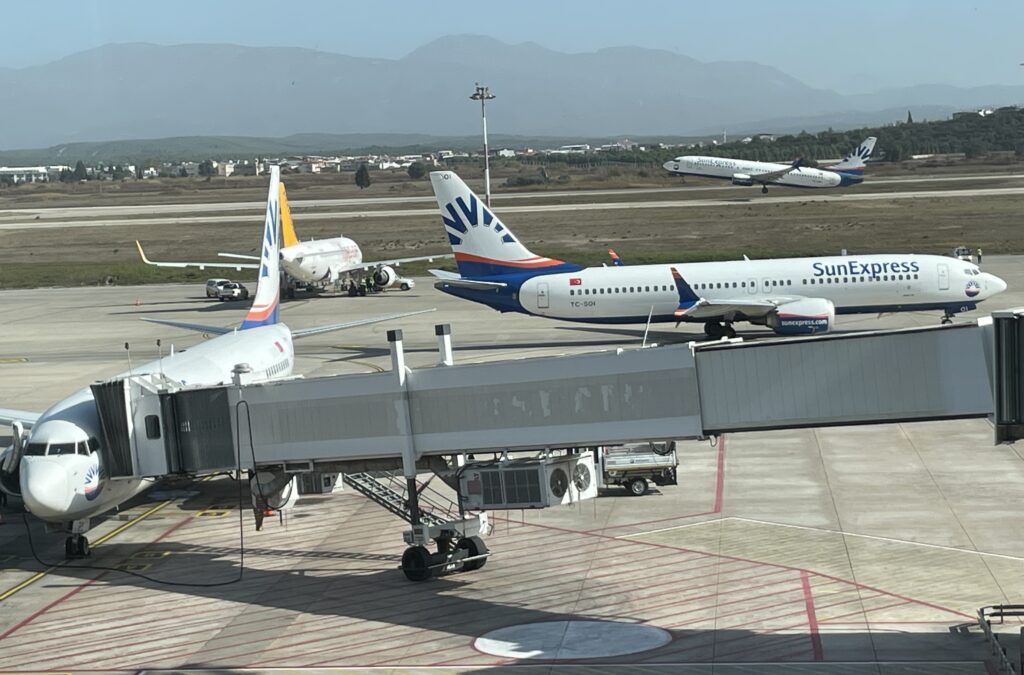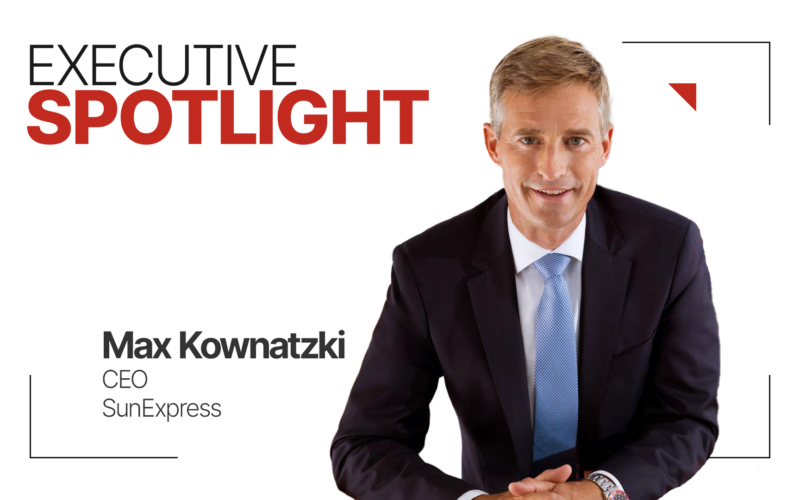At present, the Turkish airline industry is going through a period of vertiginous growth, with carriers such as Turkish Airlines and Pegasus Airlines racking up aircraft orders that run into the hundreds, while constantly adding new cities to their ever-expanding networks.
However, it was yet another carrier with Turkish roots that managed to grab the headlines on the first day of Dubai Airshow 2023 with an order for up to 90 Boeing 737 MAX aircraft (45 firm orders, five options and 40 purchase rights).
With this deal, Antalya and Frankfurt-based SunExpress has staked its claim to be considered one of the emerging stars of the European airline scene.
SunExpress is not exactly a newcomer to the market. However, for most of its three-decade long history, its activity had been mostly restricted to two very specific market niches: serving the Turkish diaspora market in Germany and flying Germans to resorts on the Turkish Riviera.
More recently, though, SunExpress has embarked on an ambitious program of expansion and diversification that is likely to open up its brand and value proposition to a much broader customer base across Europe and beyond.
At this point, it is important to highlight SunExpress’ unusual shareholding structure. The carrier is in fact a joint venture between two airline industry giants, Turkish Airlines and Lufthansa, each owning 50% of its capital.
However, this circumstance has not prevented SunExpress from operating with a remarkable degree of autonomy.
“We leverage the advantages of being agile and relatively small while also being part of two industry-leading airlines,” said Max Kownatzki, SunExpress CEO when explaining to AeroTime the relationship between SunExpress and its two parent companies.”
Kownatzki sat down with AeroTime as part of our Executive Spotlight series. The interview took place shortly after announcing, alongside Boeing, the largest aircraft order in the airline’s history.
In this wide-ranging interview, Kownatzki not only shared how SunExpress wants to use all those planes, but also talked more generally about the role he expects SunExpress to play in the always dynamic Turkish air travel market.
At present, SunExpress operates an all-Boeing fleet of 66 aircraft, a combination of 737-800 and 737-8 MAX planes. It is still awaiting the delivery of 33 aircraft from an order placed back in 2014 for 32 Boeing 737-8 MAX plus 10 options (all of which were turned into firm orders in 2019).
By 2029, when all aircraft from that previous order should come through, deliveries for the new batch of 90 aircraft signed for in Dubai will also be due to kick in.
“We have substitution rights from MAX 8 to MAX 10 in the old and new order. The 33 aircraft from the old order can also be converted to MAX 10. This means we will have our first Max 10 in 2027,” Kownatzki added.
Kownatzki confirmed that most of these aircraft are going to fuel additional growth all the way through to 2035, with only 23 being rollovers to replace aircraft currently in service.
If all goes according to plan, SunExpress expects to reach its 150 aircraft milestone in 2033 and to be operating at least 166 aircraft by 2035 – in effect, doubling in size within a decade.
But is the Turkish market able to absorb all this capacity at a time when other airlines also have their own ambitious growth plans?
“We have factored in all the standing aircraft orders from other carriers in the market, and we believe it is perfectly feasible to double in size within the next decade and remain profitable,” Kownatzki explained.
He also highlighted that the Turkish travel market has traditionally shown an amazing resilience and always bounced back, even in the face of major difficulties, not just the COVID-19 pandemic, but also other recent crises, such as the devastating earthquake that hit the country at the beginning of 2023 or long-running macro-economic woes.
“The fact is that Turkey simply offers a great value proposition compared to other competing destinations,” Kownatzki added.
Strengthening its sunny stronghold

The airline’s strategy is to use all these additional aircraft to reinforce the airline’s position in the markets where it is strongest.
In this regard, one remarkable aspect of SunExpress’ operations setting it apart from other Turkish scheduled carriers is that it avoids the country’s main air hub of Istanbul completely. Instead, it prefers to focus on providing connectivity to other Turkish cities and regions.
“Our stronghold is the Turkish Riviera, namely Izmir (ADB), Bodrum (BJV), Dalaman (DLM) and Antalya (AYT),” Kownatzki explained, adding that the airline is the market leader for the traffic between that region and the German-speaking countries.
SunExpress also operates in other areas of the country, including Ankara, the capital city, and central and eastern Anatolia, where its market share is even stronger.
“SunExpress is also the market leader for direct routes from Anatolia to Germany, Austria, and Switzerland,” Kownatzki noted.
When it comes to its product, SunExpress offers a single cabin, no frills, point-to-point model, although passengers can add some ancillaries, such as extra leg room seats and luggage.
Kownatzki explained how the ability to add these extras is particularly valued in markets like Izmir, a city that has a not insignificant share of business travelers who value the direct links that SunExpress offers to Europe and are ready to pay for a more premium experience.
When asked about the airline’s traffic profile, Kownatzki offered a detailed breakdown of its nearly 12 million annual passengers. “We have got three main markets: 45% of our traffic are leisure passengers, including charter flights for tour operators, another 45% is VFR (Visiting Friends and Relatives) mostly Turkish people living in Europe, and another 10% is domestic traffic,” he revealed.
Kownatzki, who has a background as a management consultant, joined SunExpress in early 2020 – not the most propitious of times, as the world was about to enter a prolonged lockdown. He explained that, after one of his first meetings at SunExpress, he had to rush back home to avoid getting stranded, just as airlines the world over were starting to ground their fleets.
The pandemic represented a major trial, but recovery arrived much faster than anticipated.
SunExpress returned to profitability in 2021 and was already offering more capacity, measured in average-seat-km (ASK), by the end of that year than in had in 2019. The airline has since kept growing and is expected to close 2023 with 146% of the capacity it offered back in 2019.
Expanding into new markets
Geographical diversification has played a major role in this growth story. While Germany, Switzerland and Austria remain its core markets outside Turkey, as of November 2023 SunExpress operates 175 routes and to 30 different countries.
When it comes to its network, SunExpress follows a three-pronged strategy.
“First, we are densifying our coverage of our main markets,” Kownatzki said. “We now fly seven times daily from Antalya to Düsseldorf (DUS), five times daily to Frankfurt (FRA). It is almost like a bus service.
“Second, we will also continue our expansion in the United Kingdom. We launched our first regular flights to Britain in the summer of 2022 and we are currently serving eight airports and seeing growth rates of 70 to 80%.”
“And third, we are taking advantage of opportunistic growth opportunities,” he added.
Kownatzki highlighted Spain as a country that may see more routes added following the launch of SunExpress’ first scheduled route to Barcelona earlier in 2023. The airline is also looking east, with the launch of flights to destinations such as Dubai (DXB), Abu Dhabi (AUH) and Sharm El Sheikh (SSH).
SunExpress even looked at Pakistan and India as possible growth markets, taking advantage of the fact that they are within range of its Boeing 737 MAX aircraft. However, Kownatzki said the airline had given up on the idea because traffic rights are extremely restricted in these markets.
While the absence of night curfews at Turkish airports makes it possible to schedule flights pretty much around the clock (with aircraft spending an average of 16.5 hours in the air every day, one of the highest utilization rates in the world), SunExpress faces a major limiting factor: seasonality.
Kownatzki explained that SunExpress has also been using several strategies to counter the effects of a winter trough, which could see demand falling by as much as 35% compared to the peak months of the year.
One of these strategies aims to develop partnerships that allow the airline to leverage its strong European commercial network.
“90% of our revenue is in Europe,” explained Kownatzki. “We are leveraging these commercial channels.”
For example, SunExpress takes care of sales, distribution and commercial steering in Europe for Air Cairo, an Egyptian low-cost airline, offering 87 weekly frequencies that Air Cairo operates between Germany, Austria, Switzerland, and Egypt.
In parallel to that, interline agreements with Lufthansa, United Airlines and Air Canada help channel traffic into each other’s networks.
SunExpress has also found alternative solutions to keep its aircraft busy during the quiet periods of the year.
Two Boeing 737s have been temporarily leased to South African Airways, which uses them to operate trunk domestic routes such as those between Johannesburg (JNB) and Capetown (CPT). The aircraft are on a damp lease arrangement, by which SunExpress provides the aircraft, the pilots, and the technical service, while the cabin crew is South African.
At the same time, SunExpress has partnered with MSC Cruises to make it possible for dozens of its crew members to work on cruise ships during the airline’s low season, transferring their place of work from the air to the high seas.
Kownatzki talked proudly about the airline’s crews and their flexibility and professionalism. He explained that during the COVID-19 crisis the crew’s compensation scheme was changed from a structure in which 90% of their salary was fixed and 10% flexible based on the number of duty hours, to another with a 50-50% split. This formula has since become permanent and, interestingly, with a broad endorsement among the staff.
“When we proposed this measure, everyone signed without any objections for the survival of the company during pandemic,” Kownatzki explained. “After the pandemic, as we are flying a lot more – our crew utilization rate in October 2023 was 97% – crews are earning more with this salary structure. This shows their flexibility, professionalism, and spirit.”

